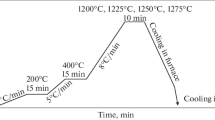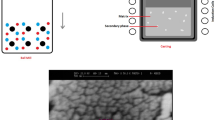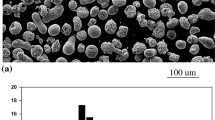Abstract
Tungsten carbide (WC) particles can be in-situ synthesized through the reaction between tungsten wires and molten of gray cast iron. The different composite coatings were obtained by adjusting the pouring temperature and the center distance of tungsten wires, and were comparatively observed by X-ray diffraction, scanning electron microscopy, and two-body abrasive wear tests. The results show that the intensities of the WC peaks increase by the increasing pouring temperature, and firstly become strong and then weak by the increasing center distance. In case of the pouring temperature 1 400 °C and the center distance 0.5 mm, the formed WC particles present quadrilateral and triangle-structure and are homogenously distributed in the matrix. The wear rate of the composite coatings for stable center distance gradually increases by increasing the loads, however, at a constant pouring temperature, it firstly decreases from 5.91 to 2.97 mg/cm2·h, and slightly increases to 3.98 mg/cm2·h by increasing the center distance.
Similar content being viewed by others
References
Z L Li, Y H Jiang, R Zhou, et al. Dry Three-body Abrasive Wear Behavior of WC Reinforced Iron Matrix Surface Composites Produced by V-EPC Infiltration Casting Process [J]. Wear, 2007, 262: 649–654
D Lou, J Hellman, D Luhulima, et al. Interactions between Tungsten Carbide (WC) Particulates and Metal Matrix in WC-Reinforced Composites [J]. Mater. Sci. Eng. A, 2003, 340: 155–162
Y F Li, Y M Gao. Three-body Abrasive Wear Behavior of CC/High-Cr WCI Composite and Its Interfacial Characteristics[J]. Wear, 2010, 268: 511–518
Do Nascimento, A M, Ocelík, V Ierardi, et al. Microstructure of Reaction Zone in WCp/Duplex Stainless Steels Matrix Composites Processing by Laser Melt Injection[J]. Surf. Coat. Tech., 2008, 202:2 113–2 120
Buytoz S, Ulutan M, Yildirim, et al. Dry Sliding Wear Behavior of TIG Welding Clad WC Composite Coatings [J]. Appl. Surf. Sci., 2005, 252:1 313–1 323
Q C Jiang, X L Li, H Y Wang. Fabrication of TiC Particulate Reinforced Magnesium Matrix Composites[J]. Scripta Mater., 2003, 48: 713–717
H Y Wang, Q C Jiang, X L Li, et al. In situ Synthesis of TiC/Mg Composites in Molten Magnesium[J]. Scripta Mater., 2003, 48:1 349–1 354
W H Jiang, R Kovacevic. Laser Deposited TiC/H13 Tool Steel Composite Coatings and Their Erosion Resistance[J]. J. Mater. Process. Technol., 2007, 186: 331–338
Razavi M, Yaghmaee M S, Rahimipour M R, et al. The Effect of Production Method on Properties of Fe-TiC Composite [J]. Int. J. Miner. Process, 2010, 94: 97–100
Li Y, Bai P, Wang Y, et al. Effect of TiC Content on Ni/TiC Composites by Direct Laser Fabrication [J]. Mater. Des., 2009, 30: 1 409–1 412
Ali Emamian, Stephen F Corbin, Amir Khajepour. Effect of Laser Cladding Process Parameters on Clad Quality and In-situ Formed Microstructure of Fe-TiC Composite Coatings [J]. Surface & Coatings Technology, 2010, 205: 2 007–2 015
D D Gu, Wilhelm Meiners. Microstructure Characteristics and Formation Mechanisms of In-situ WC Cemented Carbide Based Hardmetals Prepared by Selective Laser Melting [J]. Mater. Sci. Eng. A, 2010, 527: 7 585–7 592
Niu L, Xu Y, Wu H, et al. Preparation of In-situ (Fe,Cr)7C3/Fe Composite Coating by Centrifugal Casting[J]. Surf. Eng., 2010, 3: 675–680
L B Niu, Y H Xu, X G Wang. Fabrication of WC/Fe Composite Coating by Centrifugal Casting Plus In-situ Synthesis Techniques [J]. Surface and Coatings Technology, 2010, 205: 551–556
B Kurt, N Orhan, A Hasçaık. Effect of High Heating and Cooling Rate on Interface of Diffusion Bonded Gray Cast Iron to Medium Carbon Steel[J]. Materials and Design, 2007, 28: 2 229–2 233
B Uhrenius. Phase Diagrams as a Tool for Production and Development of Cemented Carbides and Steels[J]. Powder Metall., 1992, 35:203–210
D Cree, M Pugh. Dry Wear and Friction Properties of an A356/SiC Foam Interpenetrating Phase Composite [J]. Wear, 2011, 272(1):88–96
R Zhou, Y H Jiang, D H Lu. The Effect of Volume Fraction of WC Particles on Erosion Resistance of WC Reinforced Iron Matrix Surface Composites [J]. Wear, 2003, 255: 134–138
Author information
Authors and Affiliations
Corresponding author
Additional information
Funded by the National Natural Science Foundation of China (No. 51074123), Project of Scientific and Technological Innovation and Co-ordination Funded by Science and Technology Department of Shaanxi Province (No. KTCQ1-17)
Rights and permissions
About this article
Cite this article
Niu, L., Wang, X. & Fan, Z. Center distance and pouring temperature on in-situ synthesis of WCP/Fe composite coating. J. Wuhan Univ. Technol.-Mat. Sci. Edit. 28, 449–454 (2013). https://doi.org/10.1007/s11595-013-0711-8
Received:
Accepted:
Published:
Issue Date:
DOI: https://doi.org/10.1007/s11595-013-0711-8




